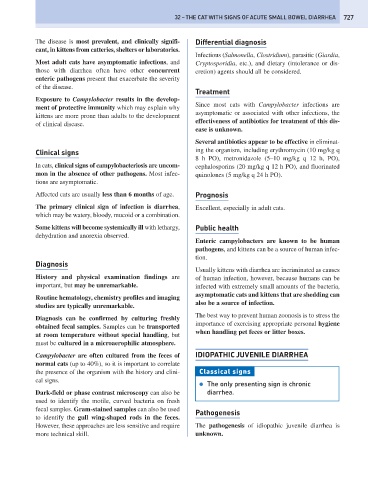Page 735 - Problem-Based Feline Medicine
P. 735
32 – THE CAT WITH SIGNS OF ACUTE SMALL BOWEL DIARRHEA 727
The disease is most prevalent, and clinically signifi- Differential diagnosis
cant, in kittens from catteries, shelters or laboratories.
Infectious (Salmonella, Clostridium), parasitic (Giardia,
Most adult cats have asymptomatic infections, and Cryptosporidia, etc.), and dietary (intolerance or dis-
those with diarrhea often have other concurrent cretion) agents should all be considered.
enteric pathogens present that exacerbate the severity
of the disease.
Treatment
Exposure to Campylobacter results in the develop-
Since most cats with Campylobacter infections are
ment of protective immunity which may explain why
asymptomatic or associated with other infections, the
kittens are more prone than adults to the development
effectiveness of antibiotics for treatment of this dis-
of clinical disease.
ease is unknown.
Several antibiotics appear to be effective in eliminat-
Clinical signs ing the organism, including erythromycin (10 mg/kg q
8 h PO), metronidazole (5–10 mg/kg q 12 h, PO),
In cats, clinical signs of campylobacteriosis are uncom- cephalosporins (20 mg/kg q 12 h PO), and fluorinated
mon in the absence of other pathogens. Most infec- quinolones (5 mg/kg q 24 h PO).
tions are asymptomatic.
Affected cats are usually less than 6 months of age. Prognosis
The primary clinical sign of infection is diarrhea, Excellent, especially in adult cats.
which may be watery, bloody, mucoid or a combination.
Some kittens will become systemically ill with lethargy, Public health
dehydration and anorexia observed.
Enteric campylobacters are known to be human
pathogens, and kittens can be a source of human infec-
tion.
Diagnosis
Usually kittens with diarrhea are incriminated as causes
History and physical examination findings are of human infection, however, because humans can be
important, but may be unremarkable. infected with extremely small amounts of the bacteria,
asymptomatic cats and kittens that are shedding can
Routine hematology, chemistry profiles and imaging
also be a source of infection.
studies are typically unremarkable.
The best way to prevent human zoonosis is to stress the
Diagnosis can be confirmed by culturing freshly
importance of exercising appropriate personal hygiene
obtained fecal samples. Samples can be transported
when handling pet feces or litter boxes.
at room temperature without special handling, but
must be cultured in a microaerophilic atmosphere.
Campylobacter are often cultured from the feces of IDIOPATHIC JUVENILE DIARRHEA
normal cats (up to 40%), so it is important to correlate
the presence of the organism with the history and clini- Classical signs
cal signs.
● The only presenting sign is chronic
Dark-field or phase contrast microscopy can also be diarrhea.
used to identify the motile, curved bacteria on fresh
fecal samples. Gram-stained samples can also be used
Pathogenesis
to identify the gull wing-shaped rods in the feces.
However, these approaches are less sensitive and require The pathogenesis of idiopathic juvenile diarrhea is
more technical skill. unknown.

